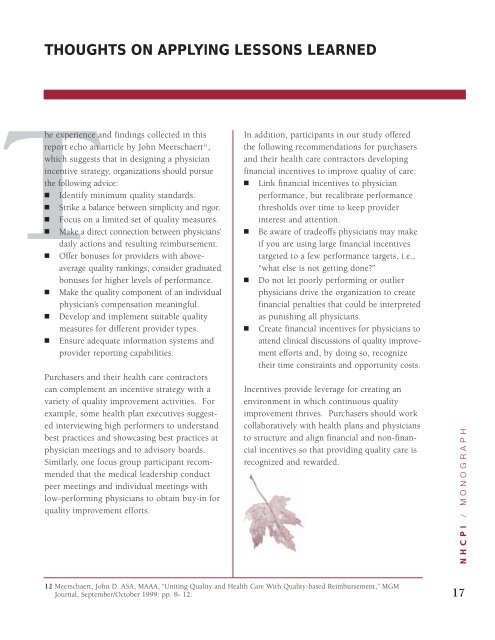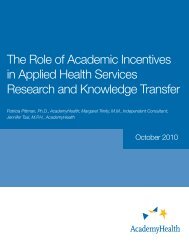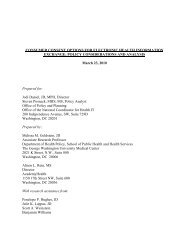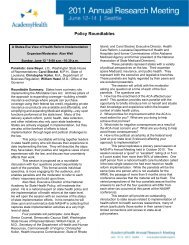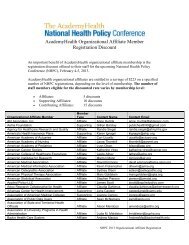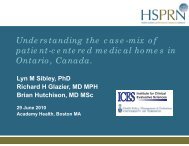The Growing Case for Using Physician Incentives to - AcademyHealth
The Growing Case for Using Physician Incentives to - AcademyHealth
The Growing Case for Using Physician Incentives to - AcademyHealth
Create successful ePaper yourself
Turn your PDF publications into a flip-book with our unique Google optimized e-Paper software.
THOUGHTS ON APPLYING LESSONS LEARNED<br />
he experience and findings collected in this<br />
report echo an article by John Meerschaert 11 ,<br />
which suggests that in designing a physician<br />
incentive strategy, organizations should pursue<br />
the following advice:<br />
Identify minimum quality standards.<br />
Strike a balance between simplicity and rigor.<br />
Focus on a limited set of quality measures.<br />
Make a direct connection between physicians’<br />
daily actions and resulting reimbursement.<br />
Offer bonuses <strong>for</strong> providers with aboveaverage<br />
quality rankings; consider graduated<br />
bonuses <strong>for</strong> higher levels of per<strong>for</strong>mance.<br />
Make the quality component of an individual<br />
physician’s compensation meaningful.<br />
Develop and implement suitable quality<br />
measures <strong>for</strong> different provider types.<br />
Ensure adequate in<strong>for</strong>mation systems and<br />
provider reporting capabilities.<br />
Purchasers and their health care contrac<strong>to</strong>rs<br />
can complement an incentive strategy with a<br />
variety of quality improvement activities. For<br />
example, some health plan executives suggested<br />
interviewing high per<strong>for</strong>mers <strong>to</strong> understand<br />
best practices and showcasing best practices at<br />
physician meetings and <strong>to</strong> advisory boards.<br />
Similarly, one focus group participant recommended<br />
that the medical leadership conduct<br />
peer meetings and individual meetings with<br />
low-per<strong>for</strong>ming physicians <strong>to</strong> obtain buy-in <strong>for</strong><br />
quality improvement ef<strong>for</strong>ts.<br />
In addition, participants in our study offered<br />
the following recommendations <strong>for</strong> purchasers<br />
and their health care contrac<strong>to</strong>rs developing<br />
financial incentives <strong>to</strong> improve quality of care:<br />
Link financial incentives <strong>to</strong> physician<br />
per<strong>for</strong>mance, but recalibrate per<strong>for</strong>mance<br />
thresholds over time <strong>to</strong> keep provider<br />
interest and attention.<br />
Be aware of tradeoffs physicians may make<br />
if you are using large financial incentives<br />
targeted <strong>to</strong> a few per<strong>for</strong>mance targets, i.e.,<br />
“what else is not getting done”<br />
Do not let poorly per<strong>for</strong>ming or outlier<br />
physicians drive the organization <strong>to</strong> create<br />
financial penalties that could be interpreted<br />
as punishing all physicians.<br />
Create financial incentives <strong>for</strong> physicians <strong>to</strong><br />
attend clinical discussions of quality improvement<br />
ef<strong>for</strong>ts and, by doing so, recognize<br />
their time constraints and opportunity costs.<br />
<strong>Incentives</strong> provide leverage <strong>for</strong> creating an<br />
environment in which continuous quality<br />
improvement thrives. Purchasers should work<br />
collaboratively with health plans and physicians<br />
<strong>to</strong> structure and align financial and non-financial<br />
incentives so that providing quality care is<br />
recognized and rewarded.<br />
NHCPI / MONOGRAPH<br />
12 Meerschaert, John D. ASA, MAAA, “Uniting Quality and Health Care With Quality-based Reimbursement,” MGM<br />
Journal, September/Oc<strong>to</strong>ber 1999: pp. 8- 12.<br />
17


